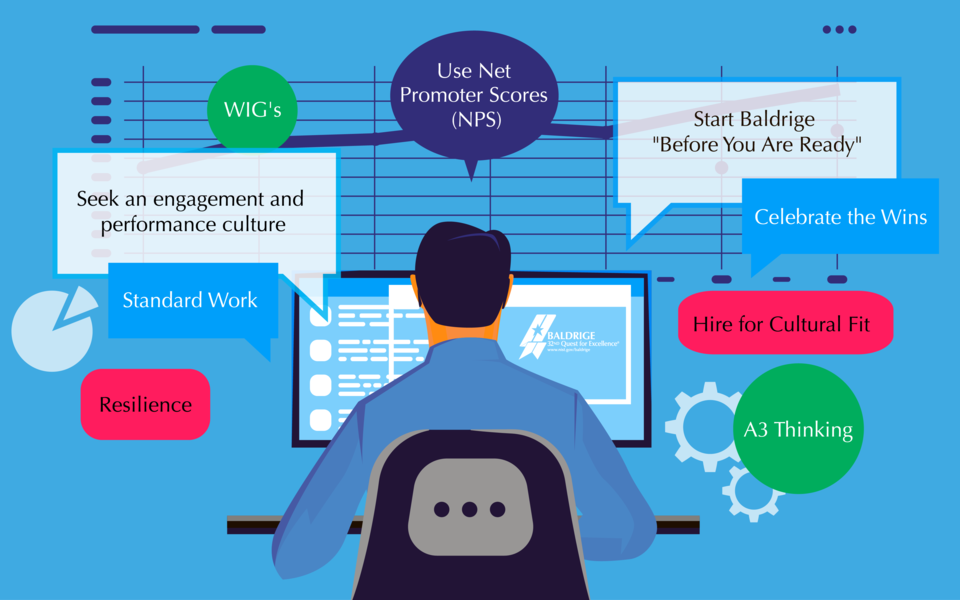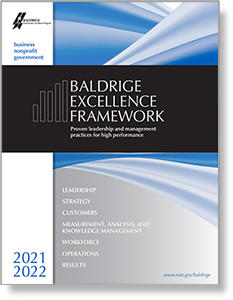Blogrige
The Official Baldrige Blog
Truly and Virtually Inspiring: The First Virtual Quest for Excellence Conference

Each year after the Quest for Excellence Conference, I sift through my notes and try to identify themes I have heard in the presentations of the new Baldrige Award recipients. The most recent summary was after the 2019 conference (the 2021 conference included recipients from the last two years).
With 11 award recipients, 11 former recipients, plenary sessions, sector-specific town halls, and 80 on-demand concurrent sessions, the sharing was richer than ever this April. I cannot claim to have digested all the information or even to have heard and seen all sessions. Nevertheless, I did hear nine very important messages that were shared by multiple recipients. Some are themes I have heard before and bear repeating since they are so important, others are new and worth sharing. There were also individual "tidbits" I heard that particularly resonated with me. I will share a few of them.
Nine Important Messages
- Seek an engagement and performance culture: Role model organizations focus on people, process, and results. The people focus includes workforce and customers, as well as other key stakeholders. In role model organizations, leaders' and employees' personal performance plans are aligned with the organization's strategic and operational plans. Every member of the organization has a line of sight to what is important to the organization.
This engagement culture has a "me and we" focus. Particularly during the challenging year we have all had, role model organizations and their leaders focused on people first, the individual needs of workforce members and the collective needs of remote-working teams. Organizations that understood the needs and new needs of their customers, and could respond to them, thrived. Culture needed to be re-enforced in new ways. Virtual (and on-site) rounding was practiced by all managers and leaders. Active listening was an extremely more important leadership skill.
Role model organizations achieve high performance through a data-rich environment. But not any data, they understand which data are important to improving and sustaining performance. These data are continuously analyzed and acted upon.
- Resilience: Role model organizations are and were prepared for the unexpected. They had systems in place to move quickly and effectively to remote work. The healthcare organizations were better prepared for the shift to telehealth and pandemic operation.
Role model organizations protected and enhanced their workforce and customer interactions, recognizing that people were anxious. They focused on the needs of their communities, as well as their own people.
These organizations have clear and high-functioning leadership systems. They were able to rapidly deploy remote decision-making and communication systems. They were transparent in their operations and in sharing their challenges.
- WIG's: Role model organizations have clearly articulated and strategic wildly important goals (WIG's). Those goals translate into strategies that are implemented throughout the organization. The goals are tied to measures that track progress on achieving the goals. The WIG's align with the organization's vision. And these organizations are agile, capable of modifying goals to deal with the unexpected.
- Standard Work: Role model organizations have defined, repeatable processes for accomplishing their work. By having standard work processes they reduce errors, inefficiency, and risk. As part of the standard work, role model organizations also have a process for improving those work processes.
- A3 Thinking: This Toyota-pioneered "thinking" process causes an organization to clearly articulate the problem it is trying to solve, analyze it, propose solutions, develop an action plan, articulate the target outcome, and assign responsibilities. It has a built-in plan-do-check-act (PDCA) cycle.
Role model organizations do not jump to conclusions. They have an organized approach to problem-solving.
- Hire for Cultural Fit: Role model organizations are committed to living their core values, They design candidate interview questions to gauge the fit of potential employees with those core values. They make sure that the core values and questions foster workforce diversity and inclusion. They recognize that it is better not to hire than to hire strictly for skills, ignoring organizational values.
- Use Net Promoter Scores (NPS): As part of being data-rich, role model organizations know how they are doing in the eyes of their customers. An effective, highly benchmarked process for customer experience management is to use the NPS. On a scale of -100 to 100, the NPS measures the likelihood of customers to recommend your organization, product, or service. And our role model organizations achieve high NPS scores.
- Start Baldrige "Before You Are Ready": Role model organizations realize you are always ready to start using the Baldrige Excellence Framework. The Framework meets you where you are as an organization and helps you move to the next higher level of performance. If you postpone Baldrige "until you are ready," you will either never be ready or slow down progress that you could be making today.
- Celebrate the Wins: Role model organizations know the importance of celebration. Even easy wins are worth celebrating. If you focus only on challenges and problems, you lose sight of the progress your organization is making. Celebrations emphasize accomplishments and strength; celebrations build organizational pride and are part of the culture of role model organizations.
A Few Tidbits
- Data: While I have already mentioned the importance of using data and analysis, I heard a new twist on using data from Kate Hetherington of Howard Community College. Her statement was, "Look at the data, remove the drama." This was one of the best expressions of management by fact that I have heard. Remember this statement next time decision-making in your organization becomes emotional!
- Returning to the "Office": In looking at the "new normal" for work as we come out of pandemic restrictions, Brian Collins of the Illinois Municipal Retirement Fund (IMRF) stated that when possible the IMRF will return fully to their shared space to give people a chance to re-establish personal relationships and IMRF's strong culture. After that, they will look at what their long-term blended work environment should be.
- Susanisms: Susan Stuart of the Center for Organ Recovery & Education (CORE) shared some of her Susanisms. These are simple practices that are part of CORE's operating guidelines that show attention to detail and careful intentionality in everything they do . They are powerful, unspoken messages that are picked up by staff and customers. A couple of examples that were shared include always leaving conference room blinds up and fully open and pushing chairs into the conference table when a meeting ends.
What Next?
Now that you know some of my lessons learned or re-enforced by the speakers at the Quest for Excellence Conference, think about your organization. Are you using these practices? What insights do they provide into your organization? What will you change or improve? How have you been inspired? I wish you success on your journey to performance excellence!

Baldrige Excellence Framework
The Baldrige Excellence Framework has empowered organizations to accomplish their missions, improve results, and become more competitive. It includes the Criteria for Performance Excellence, core values and concepts, and guidelines for evaluating your processes and results.
Purchase your copy today!
Available versions: Business/Nonprofit, Education, and Health Care





